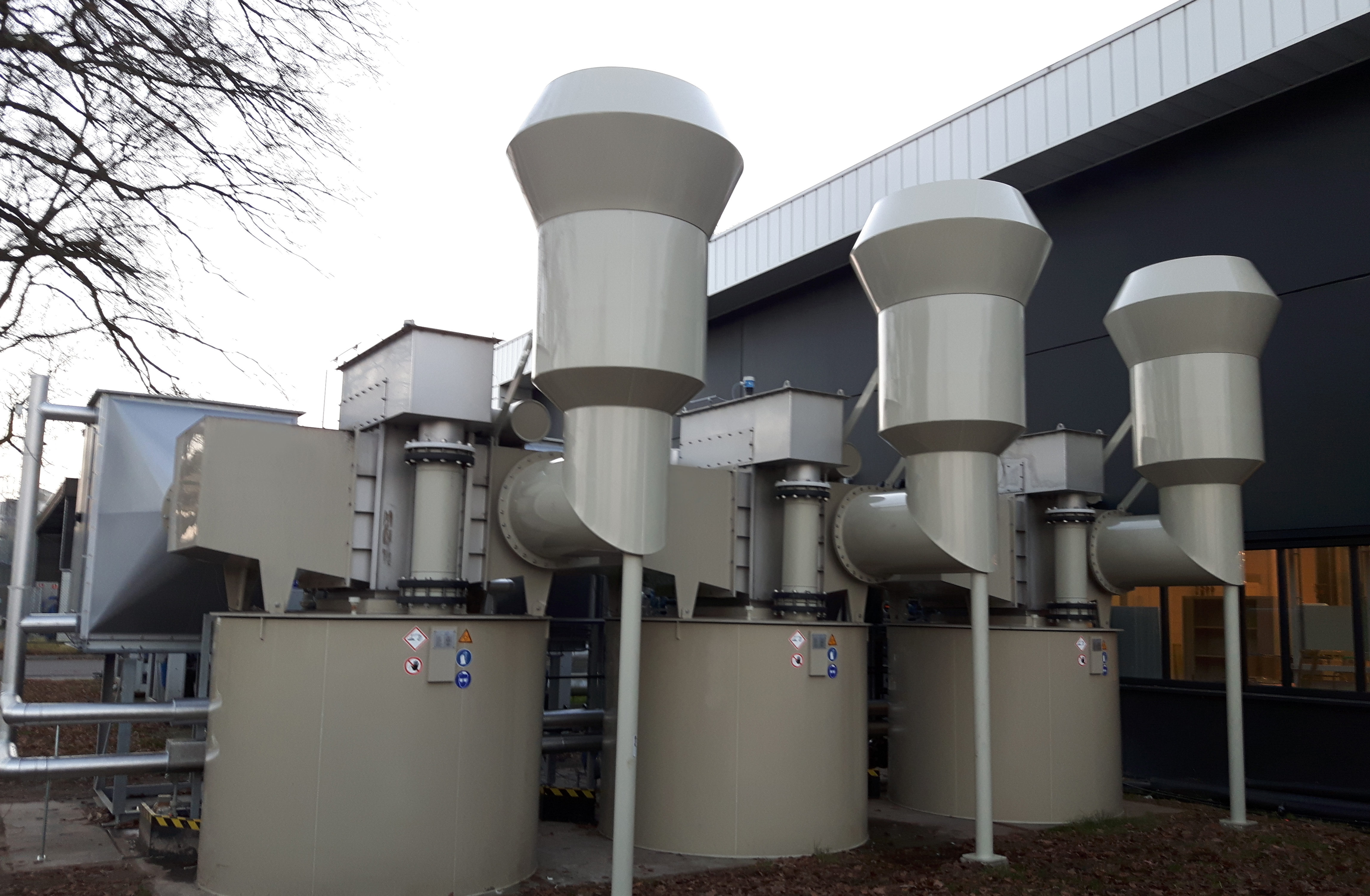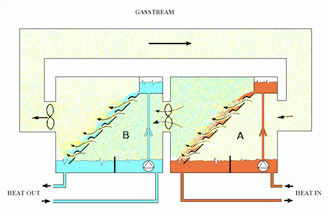GaLiCos and Crescendo
GaLiCos is short for Gas Liquid Contact System and can be applied for evaporation (thickening of liquids), scrubbing of (hot) gasses, stripping, cooling and a range of related purposes. Crescendo is the newest development of the stainless steel GaLiCos: an optimised synthetic design especially suited for extremely corrosive conditions, such as liquids with a very high or very low pH and brines.
Working Principle:
The liquid flows down along an inclined plate and generates by cavitation a slightly negative pressure in the downward directed, protruding openings that are present on the upper surface of this plate. The negative pressure causes the gas to pass from underneath the plate into the flow of liquid as long stretched bubbles. Those bubbles stay long enough in contact with the liquid to become saturated with vapour exchange other components or thermal energy. A low pressure ventilator will transport the gas and enhance the gas/liquid contact.


This patented method provides a very intensive gas/liquid contact, offering an optimal exchange of components at minimal energy input. Even waste energy e.g. from heating, cooling and ventilating may be put to good use.
Features:
Low energy consumption
Not sensitive to fouling
Compact, modular and robust construction
Simple operation and no maintenance
GaLiCos and Crescendo
GaLiCos is short for Gas Liquid Contact System and can be applied for evaporation (thickening of liquids), scrubbing of (hot) gasses, stripping, cooling and a range of related purposes. Crescendo is the newest development of the stainless steel GaLiCos: an optimised synthetic design especially suited for extremely corrosive conditions, such as liquids with a very high or very low pH and brines.
Working Principle:
The liquid flows down along an inclined plate and generates by cavitation a slightly negative pressure in the downward directed, protruding openings that are present on the upper surface of this plate. The negative pressure causes the gas to pass from underneath the plate into the flow of liquid as long stretched bubbles. Those bubbles stay long enough in contact with the liquid to become saturated with vapour exchange other components or thermal energy. A low pressure ventilator will transport the gas and enhance the gas/liquid contact.

This patented method provides a very intensive gas/liquid contact, offering an optimal exchange of components at minimal energy input. Even waste energy e.g. from heating, cooling and ventilating may be put to good use.
Features:
Low energy consumption
Not sensitive to fouling
Compact, modular and robust construction
Simple operation and no maintenance

GaLiCos is the best solution for:
Wastewater streams can be concentrated in a Galicos module at low cost using waste heat from e.g. ventilation air or outside air.
In this process, the airflow is almost saturated with vapor of the liquid due to the large contact area between thousands of elongated bubbles and the film-shaped liquid flow.
The evaporation capacity depends on the temperature and relative humidity of the applied airflow.
The airflow saturated with moisture can usually be discharged directly into the atmosphere. If the disposed airflow contains hazardous substances (such as vapors of hydrocarbons) additional measures are needed.
Contaminated ventilation air or flue gases can be washed by leading the gas stream through one or more GaLiCos Units (see working principle).
Dust and soot particles are trapped in the liquid while caloric energy (when present in the gas flow) can be recovered.
The unique features of the system regarding prevention of fouling and cleanability enable application of the technology on highly fouling, scaling forming liquids.
Another possible application for GaLiCos is biogas scrubbing (H2S removal).
Volatile substances can effectively be removed from a liquid such as wastewater or drainage water. This is accomplished in the GaLiCos system by evaporating them in the relatively large gas (air) flow that is intensively brought into contact with the fluid.
The unique features of the system regarding prevention of fouling and cleanability enable application of the technology on highly fouling, scaling forming liquids.
Volatile substances (when present) can be condensed and recovered by leading the gas stream through a second GaLiCos unit.
In the first GaLiCos module, the recirculating gas stream absorbs evaporation heat and some (clean) vapor from the contaminated hot fluid.
In the second GaLiCos module, this gas stream condenses in the cooler into cleaner liquid and the absorbed evaporation heat is released to the liquid as condensation heat.
Besides the intended liquid-liquid heat transfer also a relatively small amount of liquid is recovered from the contaminated liquid.
The heat exchange capacity depends on the (average) temperature.

Benefits:
- High heat transfer capacity (W/m². K)
- Suitable for heavily contaminated liquids
- Easy to clean
- Makes recovery of low-grade energy cost-effective
- Low own energy consumption
- Practically no maintenance

 Nederlands
Nederlands Deutsch
Deutsch